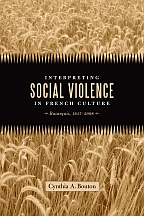
272 pages / 9.00 x 6.00 inches / 8 halftones, 4, line drawings
History / West European | History / France
In January 1847, a grain convoy passed through Buzançais, an obscure village in a remote region of central France that was suffering from hunger, high prices, and widespread unemployment. Villagers intercepted the shipment, invaded granaries and mills, and forced resale of the grain at a just price set by the people. What started as a classic subsistence movement, however, triggered two days of rioting and class hostility punctuated by uncommon property damage and death. Disorder soon spread throughout the region. The Buzançais riot quickly became an evocative symbol of the rights of the people, and stories about the riot have survived into the twenty-first century.
In Interpreting Social Violence in French Culture, Cynthia A. Bouton traces how the production and marketing of the Buzançais riot story served political commentators, publishers, authors, illustrators, and local enthusiasts, enabling them to draw upon key points from the 1847 uprising to negotiate issues relevant to their own times. Bouton argues that over time, especially from the 1970s, the persistent integration of stories of social protest into a widening variety of media has helped shape French political identity as one in which the politics of the street has become as customary as the politics of political assemblies.
Bouton examines representations of the riot in newspapers, novels, illustrations, popular and scholarly historical narratives, cartoons, television, local spectacles, and on the Internet. She analyzes power relations embedded in texts and in images; the ways in which texts and images complement, complicate, and contradict each other; and the ways in which history, memory, and fiction intersect. Both in 1847 and subsequently, she shows, efforts to reorder the disorder at Buzançais have exposed aspects of French social and cultural attitudes and practices. She demonstrates that the particular media employed to tell the Buzançais story both constrained and empowered the messages conveyed by textual and visual narratives of it, perhaps as much as the ideological positions of authors, illustrators, or producers.
By probing the relationship between medium and story in relation to the Buzançais riot, Interpreting Social Violence in French Culture offers a new interpretation of this defining moment in French history.
Cynthia A. Bouton is associate professor of history at Texas A&M University and the author of The Flour War: Gender, Class, and Community in Late Ancien Régime French Society.
“Bouton presents an analytical history rooted in detailed research and willing to absorb an ever-growing number of creative efforts. . . . This is an accomplished work that straddles a variety of genre and presents new perspectives on old debates.”—Journal of Social History
“An illuminating and well-researched study.”—Journal of Interdisciplinary History
“[A] wide-ranging and insightful recounting [of] the Buzançais uprising. . . . Bouton’s exploration and contextualization of Buzançais’s reverberations are among the most important contributions of this fine study.”—Social History
“Too much cannot be said of the depth and insight of Bouton's analysis. This is a splendid book.”—French Studies
“In this book Cynthia A. Bouton undertakes an original and very engaging exercise of historiography.”—American Historical Review
Found an Error? Tell us about it.